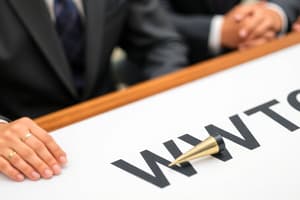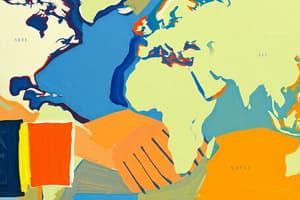Podcast
Questions and Answers
What significant event led to the global financial crisis of 2008-2009?
What significant event led to the global financial crisis of 2008-2009?
easy money, low interest rates, subprime mortgages, mortgage-backed securities
What were some core factors that contributed to the recession in the EU during 2007-2011? Select all that apply.
What were some core factors that contributed to the recession in the EU during 2007-2011? Select all that apply.
- Decline in external demand (correct)
- Decline in trust in financial markets (correct)
- Homemade real estate bubble
- Losses of financial institutions exposed to toxic US assets (correct)
Which organization reacted quickly to the crisis despite not anticipating it?
Which organization reacted quickly to the crisis despite not anticipating it?
- IMF (correct)
- EU
- G20
- ECB
The ECB actively participated in supporting private financial institutions during the crisis.
The ECB actively participated in supporting private financial institutions during the crisis.
What is the role of the Troika in economic governance?
What is the role of the Troika in economic governance?
The Stability and Growth Pact (SGP) has two main arms: the Preventive arm and the Corrective arm. The Corrective arm is triggered when a country's budget deficit exceeds __% of the GDP, or when public debt exceeds __% of the GDP.
The Stability and Growth Pact (SGP) has two main arms: the Preventive arm and the Corrective arm. The Corrective arm is triggered when a country's budget deficit exceeds __% of the GDP, or when public debt exceeds __% of the GDP.
What were some of the European Union members that needed emergency lending during the financial crisis?
What were some of the European Union members that needed emergency lending during the financial crisis?
Which country in the Eurozone faced high government deficits, public debt, and an inability to refinance debt?
Which country in the Eurozone faced high government deficits, public debt, and an inability to refinance debt?
What institution had not anticipated the crisis but reacted quickly by providing new lending facilities and arrangements for borrowing from members?
What institution had not anticipated the crisis but reacted quickly by providing new lending facilities and arrangements for borrowing from members?
The ECB actively engaged with private financial institutions and started supporting governments during the crisis.
The ECB actively engaged with private financial institutions and started supporting governments during the crisis.
The Stability and Growth Pact (SGP) consists of two arms: preventive arm and __________ arm.
The Stability and Growth Pact (SGP) consists of two arms: preventive arm and __________ arm.
Flashcards are hidden until you start studying
Study Notes
Negotiation Strategies
- Leading and coordinating parallel negotiations at different levels requires substantial resources.
- This strategy has been crucial for advanced industrialized countries in pushing through the TRIPS Agreement in the Uruguay Round.
- It has been used to promote "TRIPS-plus" provisions, while the WTO moved to create more flexibility on TRIPS.
Structural Shifts and IOs
- There is a structural trend towards less dominance of advanced industrialized countries in the international economy.
- However, further fragmentation seems to be under way.
- While structural shifts suggest changing order, it is too early for conclusions.
- New dynamics of governance are emerging, such as the BIC alliance and recent isolations of China.
- There are tensions over "reform" in the WTO, particularly with the US contestation of the Appellate Body.
Trade Governance Beyond WTO
- Regional agreements have been used to bridge the gap, but also strategically, especially by advanced industrialized countries.
- These agreements promote preferred regulatory agendas, including through forum-shifting.
The IMF and EMU Before, During, and After the Eurozone Crisis
- The global financial crisis of 2008-2009 was triggered by the 1st half of the 2000s, which saw years of easy money, low interest rates, and easy access to mortgages.
- The crisis was exacerbated by the rise in interest rates from 2004, leading to defaults on subprime mortgages.
- The result was a widespread reluctance to give credit, and risk of insolvency for many financial firms.
- Heavy government and central bank involvement was needed to address the crisis.
The IMF's Response
- New IMF loans surged from virtually nothing in 2007-2008 to the highest levels in history in 2009.
- There was extensive cooperation amongst central banks to address the crisis.
The EU's Experience
- The EU members were amongst the first to suffer the crisis.
- All major European economies experienced recession (negative GDP growth) between 2007 and 2011.
- Core factors contributing to the recession in the EU include:
- Losses of financial institutions exposed to "toxic" US assets.
- Decline in trust in financial markets.
- Decline in external demand.
- In some cases, homemade real estate bubbles and other factors contributed to the recession.Here are the study notes:
Large Government Deficits and Public Debt
- Several new EU members needed emergency lending to tackle high levels of external public debt and refinancing difficulties
- Examples: Hungary (Oct 2008), Latvia (Dec 2008), Romania (May 2009)
- Other EU members required emergency lending due to large government deficits, high public debt, and inability to refinance
- Examples: Greece (May 2010, March 2012, July 2015), Ireland (Dec 2010), Portugal (May 2011), Spain (July 2012), Cyprus (April 2013)
Impact on the IMF and Global Economic Governance
- IMF reacted quickly to the crisis, adopting new lending facilities and instruments
- IMF lending multiplied by 73 between spring 2008 and spring 2009
- New arrangements for borrowing from members and concessional loans for low-income countries
- Broader shifts in global economic governance, with the G20 emerging as a center of international macroeconomic coordination
- The crisis marked a shift away from the Washington Consensus, with a more multipolar economic elite emerging
EMU Governance and the Crisis
- The "M" in EMU (Economic and Monetary Union) refers to monetary policy, but does not account for differences in growth performance among members
- No exchange rates to help adjustment, and no common fiscal policy or "bailout" clause
- The ECB acted to support governments, purchasing government bonds and providing non-standard measures to preserve the Euro
- Concerns about excessive financial and political risks led to pressures on states to develop their own support mechanisms
Changes during the Crisis
- "No bailout" clause (Art. 125 TFEU) was circumvented through ad hoc solutions, such as the Greek Loan Facility and the European Financial Stability Mechanism (EFSM)
- The European Stability Mechanism (ESM) replaced the EFSM and EFSF, providing a permanent stability mechanism with strict conditionality
- TheSix Pack, Fiscal Compact, and Two Pack reforms aimed to strengthen fiscal discipline and surveillance
- The European Semester was introduced to provide a framework for coordination and surveillance of national economies
The Role of the IMF
- The IMF contributed to lending programs in Greece, Ireland, Portugal, and Cyprus
- The IMF was part of the "troika" with the European Commission and ECB, with differing views on debt sustainability and fiscal targets
- The IMF shifted away from the Washington Consensus, focusing on limited, "macro-relevant" measures and Keynesian ideas
EMU and the Crisis
- The ECB was key in creating stability during the sovereign debt crisis
- Incomplete fiscal union remains a challenge, with piecemeal reforms installed to create financial support mechanisms and strengthen the SGP
- The EMU has become more supranational in some areas, but more intergovernmental in others
- The EU has undergone profound changes, with a shift towards more integration of economic policies across the entire EU
Conclusions
- Global connectedness makes it easier for crises to spread
- The crisis highlights the need for international cooperation and innovation in economic governance
- Major IOs have adapted to the crisis, but more slow reforms are needed
- The crisis underlines structural shifts in global economic governance
Studying That Suits You
Use AI to generate personalized quizzes and flashcards to suit your learning preferences.




